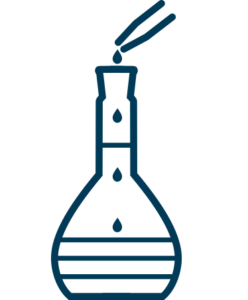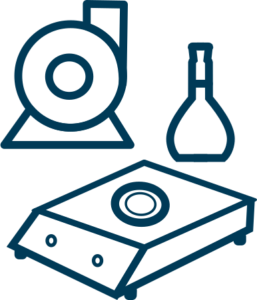Our history. Where did we come from? More than two decades have passed since Questron established a presence in Canada. During this time, so much has happened, both in our personal lives as well as in the world at large. It is for this reason that I thought of standing back and reflecting on our history, not only to appreciate and learn from our past but also to provide a sense of continuity for curious newcomers to Questron. It is an incontrovertible truth that path to success is never a straight line; in fact, the path is crooked as can be, with many tribulations and some happy moments of clarity. It was and it is so with Questron. A word of caution to the reader. While reading this, please take note that these three pages are a synopsis of 30 years of dynamics. Of necessity, this means many key figures and events have been missed in this brief account of our journey.
Angelo Grillo, a pioneer in Sample Analysis Marketing, after serving as President of Jobin-Yvon, a French maker of spectrometric products, started Questron in the mid-80’s to develop the concept of using microwave energy for sample digestions. Questron was the first company to add temperature profile regulated digestions feature to the microwave. At that time, Questron was based in Mercerville (near Princeton), NJ, USA.
In 1990, Manny Phull and Mark Schellenberg launched a startup corporation called Trulogic Systems Inc. as a refurbisher and service provider for spark and ICP spectrometers. During this time, until 1999, Trulogic provided electronic and computer upgrades for ICP and Spark instrumentation. Initially, these were DOS products but, as permitted by time, these were updated to Windows.
Why did we, the Questron entrepreneurs, want to get into sample prep? Samples analyzed on an ICP often require sample preparation. So, having significantly garnered knowledge of the ICP instrument and the applications thereof, it was a natural. ICPs require homogenous, liquid samples for analysis. So, sample prep of diverse samples from mining, environmental, manufacturing, and food processing applications is required for the analysis of the analyte. For this reason, initially, Manny decided to distribute sample prep products manufactured by Questron, at that time located in New Jersey, as well as a few other allied products from other suppliers. In time, this led to further developments and opportunities that saw us becoming equity owners of Questron.
In 1999, Manny and Mark acquired Questron Corp of NJ and relocated it to Mississauga, Canada, and renamed it Questron Technologies Corp. The company expanded its sales network in the ensuing six years. Until 2002, Questron sold the inherited (legacy) instrumentation of old Questron. Beginning in
2002, the products were slowly updated to keep them current. However, serious new developments on which our current products are based, were started in 2007.
In the microwave boom around 2007, largely created by over-enthused players in the microwave field, we did an unexpected about face and acted on the belief that microwave digestions, although having many benefits, were not best suited for every digestion type, need and requirement. In fact, even at that time and at present, most sample digestions were still carried out by the competing block digestion and hot plates techniques in manual mode. In order to exploit the key advantages of block digestion, namely safety due to open vessel digestion, and large throughput capability afforded by the large number of digestion tubes that could fit on one block, Questron decided to automate block
digestion process. Vulcan was thus developed around the block digestion concept but with automated features. In fact, a rudimentary automation workstation called Autoprep was prototyped in 2004. It was based on a heated water bath rather than heated blocks and was delivered to USEPA in Chicago.
In 2007, the Autoprep station was re-built with heated blocks and syringe dispensing modules. It had polycarbonate body with metal screws and bolts. It was a long, winding road from that rudimentary design to the current Vulcan product.
In 2009, QPrep, the automated dilution and transfer system, was introduced. Again, it was a design in its infancy and hardly resembled the current product. That required another four years of refinements. In 2009, under Mark’s leadership, the all-plastic body using refined plastic welding technique was introduced and was employed to create the new Autoprep, now renamed Vulcan. This System could heat samples to 230 deg. C and was rated for use with most acids, including perchloric. At this time, the first design of our 6-channel syringe pump driven by a single motor was also introduced. In the same time frame, Ken Mehta, Questron’s then Marketing Manager, hired a young Suhas Narkhede. Both these individuals contributed significantly to the refinements needed for the Vulcan, as gathered from the short list of our customers and percolated in the collective mind of Questron staff.
In 2010 the initial design of QBlock wireless system was introduced. In parallel with this, QLab Pro, a redesigned Microwave digestion system with a newly designed oven cavity and our VHP vessel set, was introduced. Needless to say, this initial design went through many changes in the subsequent five years to make the QLab product, and ultimately to the recently launched QWave system. The non-metal construction of a thermocouple with its working principle of a temperature-dependent optical signal travelling in a fiberoptic cable was introduced in the then QLab. It can be generally stated that after many innovations coming from Mark and after a few triumphs and many failures, we had to abandon this device. In 2013 this was replaced by non-contact temperature sensing of all vessels through infrared sensing technique that is in use today on our eVHP and LVHT microwave vessel types.
In 2011, QLab Pro eVHP vessel set was introduced. It has continued its steady stream of improvements in manufacturing and reliability-based design till today.
In 2012, our dual syringe drive pump was introduced for its application on the QPrep, a liquid transfer system for sample preparation. At this same time, we significantly refined the QAsh 1800 system, originally purchased with the assets purchase of Questron (New Jersey). New electronics, new software and many hardware pieces such as the microwave heating plates, a newly designed furnace, a temperature bar graph, and a higher capacity air cooling system cavity were incorporated into the design in the ensuing three years.
In 2016, the QLab Pro, in order to increase its system throughput, was provided the LVHP close vessels. The LVHP, later renamed LVHT, continued its design refinements. In 2022, LVHT vessel set is an integral offering of the QWave Microwave digestion system.
In 2017, Nitron, the high temperature automated digestion system was introduced, to process the high temperature, open vessel digestions in an automated fashion, similar to its cousin, the Vulcan. These high temperature digestions, requiring over 300 deg. C heating as well as use of high boiling-point acids such as sulfuric acid, have some demanding challenges of exhaust fumes that tend to precipitate their acids content before the journey out of the instrument. This system was primarily designed to the
specification of LG, a Korean maker of electronics products. Currently, this product is earmarked for focus in our digital marketing efforts.
The years 2019 to 2022 can be earmarked as “Covid” years and saw a time period of deep introspection for Questron. In particular, our launch in conjunction with NRC-IRAP, a federal agency for promoting Canadian innovations, of our Lambda product was approved and started in mid-2020. It is ongoing at the time of this writing. We believe, this new product concept will infuse significant innovation into the microwave digestion technique and lead it into a Vulcan kind of automation for microwave assisted digestions.
Post Covid, we are entering interesting times. A non-ending stream of improvements in Internet, data processing, and miniaturization of electrical and mechanical components is opening up so many disruptive possibilities in the way we do sample prep. New paradigms in the fields of economics, banking and marketing are leaving many behind in the dust, but urging others to wake up and look soberly internationally at the emerging future. New possibilities in the giants of human populations – China and India, and others – are stirring after centuries of slumber. These giants are readying themselves for a new world order.
The senior management of Questron may be lacking in the physical energy that we had twenty years ago. But that is amply made up in the benefits of hard gained experience and new young talent that is coming in at a steady pace to Questron. The drive to innovate, help our clientele, achieve and succeed is still strong. Questron is entering interesting times.
Manjinder Phull, P.Eng.
Mississauga, Ontario
May 20, 2022




